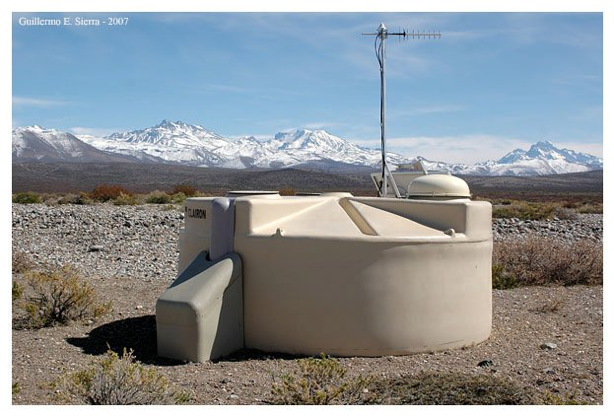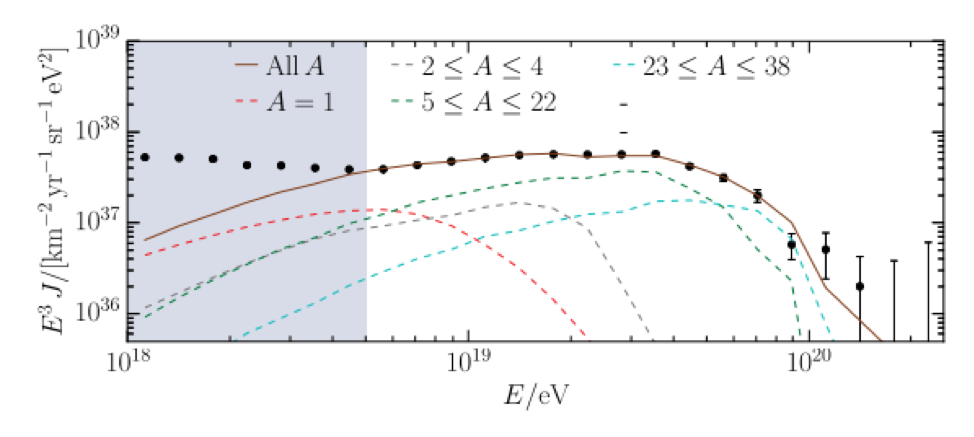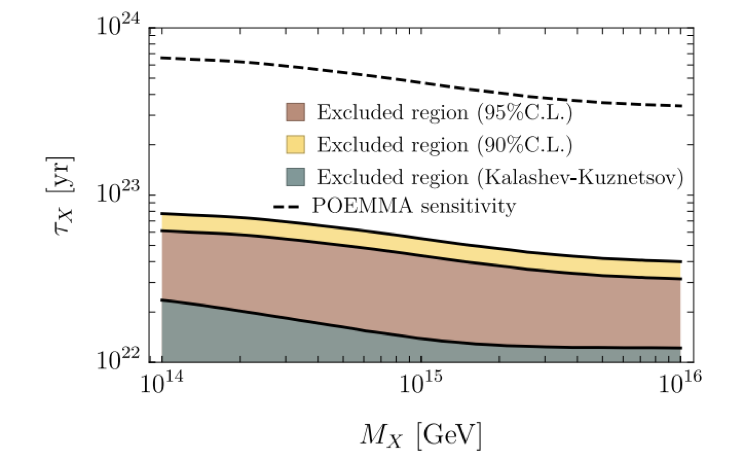Oh-My-God (Particle), It’s WIMPzilla!
By Shawn Westerdale, September 11, 2019
Article: “Hunting for superheavy dark matter with the highest-energy cosmic rays”
Authors: Esteban Alcantara, Luis A. Anchordoqui, and Jorge F. Soriano
Reference: https://journals.aps.org/prd/abstract/10.1103/PhysRevD.99.103016
Since we’ve recently had a couple posts about Ultra High Energy Cosmic Rays (UHECRs) by Abhinav (The Oh-My-God Particle) and Gevy (Astrophysical particle accelerators), I figured I’d follow up with another article that puts a different spin on UHECRs: Can they be explained by decays of ultra high mass dark matter particles?

Figure 1: An artistic rendering of a WIMPzilla producing an Ultra High Energy Cosmic Ray [Image source]
I’ll cite the great posts by Abhinav and Gevy as references to explain what UHECRs are in more detail. In short, there have been a number of observations of cosmic rays at mind-blowingly-high energies (to use the technical term), well above the upper bound of what should be present. This upper bound is called the GZK cutoff and comes from the fact that higher energy cosmic rays will scatter on the CMB and lose energy until they fall below this energy, around 5×1019 eV. However, a number of cosmic ray observatories have detected rare events well above this cutoff, though their origin is unknown.
While many explanations for the UHECRs have been proposed, none are yet verified. One possible explanation is that they may be produced by superheavy dark matter. When I say super heavy, I mean ultra heavy, like on the scale of the Planck mass. If such dark matter particles exist and decay to Standard Model particles with a very long lifetime (a long lifetime is needed if they’re going to explain the dark matter observed today rather than it all decaying away), then their decay products may explain UHECRs. A class of dark matter that would fall in this mass range is commonly called WIMPzillas, for obvious reasons. Figure 1 depicts the process of such a WIMPzilla producing a UHECR.
In this post, I’m going to focus on measurements made by the Pierre Auger Observatory, and limits that have been placed on the WIMPzilla half life based on the highest energy UHECRs observed by the observatory.
What are WIMPzillas?
WIMPzillas are a class of superheavy dark matter particles (with masses up to the Planck scale) produced out of thermal equilibrium in the early universe. This paper by E. Kolb, D. Chung, and A. Riotto explains the underlying idea in great detail.
A number of mechanisms have been proposed as ways of producing WIMPzillas out of thermal equilibrium in the early universe that would result in the observed dark matter density. Many of the most common mechanisms involve gravitational production, which allows their abundance to be independent of their coupling to the Standard Model, making these theories quite flexible.
One example theory put forth by D. Chung, E. Kolb, and A. Riotto is presented in this paper. The basic idea is as follows: in quantum mechanics, we learn that if you take some wave function that’s in the ground state of a potential and suddenly change the potential, the wave function will not have had time to evolve with the potential into its new ground state. Instead, it will be in some excited state. Now consider a WIMPzilla field in the ground state of the very early universe. When the universe very rapidly expands during inflation, it changes the gravitational potential well felt by this field. This change results in the WIMPzilla field being in an excited state; these excitations manifest as particles. In theories like this, the resulting WIMPzilla abundance depends mostly on its mass and on the details of the inflationary theory. However, it turns out that a particle with a mass within a few orders of magnitude of 1013 GeV/c2 can give the appropriate abundance of dark matter to agree with cosmological observations.
One thing that’s true of most dark matter theories is that if it exists today at the observed abundance, it must either be stable or have a very long lifetime compared to the age of the universe. However, a few groups (e.g. V. Berezinsky, M. Kachelrieß, and A. Vilenkin) have shown that decays of WIMPzillas, or interactions within a more complicated dark sector including WIMPzillas, can produce UHECRs.
What is the Pierre Auger Observatory?
The Pierre Auger Observatory is a cosmic ray observatory in Argentina that was designed to detect UHECRs. This observatory uses the universe as a collider and the earth as a detector.


Figure 2. (Top) Surface detector. (Bottom) Fluorescence detector. [Image source]
The observatory consists of an array of surface detectors and fluorescence detectors covering 3,000 km2. The surface detectors are water Cherenkov detectors arranged into triangular patterns of different sizes, that detect Cherenkov light when relativistic charged particles pass through them. The fluorescence detectors are UV observatories that produce high-speed pictures. Figure 2 shows photographs of both kinds of detector.
When a UHECR enters the atmosphere, it interacts with atmospheric nuclei to produce a large shower of charged particles. When these charged particles enter the surface detectors, they produce very fast Cherenkov light that allows the detectors to identify the event and where in the sky it is occurring. The fluorescence detectors can then record the track produced in the sky, based on UV light emitted by the track. This technique of using two different types of detectors also allows them to be cross-calibrated to reduce systematics.

Figure 3. The energy spectrum measured by the Pierre Auger Observatory. Figure source.
The observatory has been taking data for about 15 years now. FIgure 3 shows the energy spectrum that they observed. Note that these energies out beyond 1020 eV — that is 100 EeV!
What can we say about WIMPzilla decays?
Now, with all of that said, I can finally talk about the paper at the top of this post. Alcantara et al. consider the full energy spectrum of UHECRs observed by the Pierre Auger observatory over the course of 15 years.
The authors of this paper argue that if WIMPzillas exist and have a very weak coupling to the Standard Model that allows them to hadronically decay, they may produce ultra high energy photons close to the Earth, that would result in observed UHECRs.
The authors note that the Pierre Auger Observatory has seen no UHECRs above 1011.3 GeV in the 15 years, over which they had a total exposure of 67,000 km2 sr yrs. This results in an upper limit on the flux of UHECRs above this threshold of J(E>1011.3 GeV) < 3.6×10-5 km-2 sr-1 yr-1.
Assuming some WIMPzilla with a given mass, they use the local dark matter density from the Standard Halo Model to predict the number of WIMPzilla decays they would expect to see, given this exposure and some half-life. Based on the upper limit on the total flux of UHECRs above 1011.3 GeV, they can therefore place a lower limit on the half life of a WIMPzilla with some mass.

Figure 4. The lower limit on the WIMPzilla half-life resulting from this analysis — Figure 3 from the paper.
The results of this analysis are illustrated in Figure 4. For a given WIMPzillas mass, the excluded half-lives are shown in the shaded regions. The authors also project the sensitivity of a future UHECR observatory called POEMMA.
So what does this tell us about dark matter? WIMPzillas could always exist and be stable, in which case this type of search would be insensitive to them. However, once we’re talking about half-lives much longer than the age of the universe, they could decay, and so these searches looking for WIMPzilla decay are still excluding interesting regions of parameter space. And who knows? These superheavy dark matter models often don’t get as much attention as lower-mass models, and this decay mechanism probes different Standard Model couplings than we might see in direct detection experiments. Given that we still don’t know what dark matter is, it’s worth looking everywhere. Now we have a better idea of where dark matter probably isn’t.


About Shawn Westerdale
I am a postdoctoral fellow at Carleton University in Ottawa, working on the DEAP-3600 direct dark matter detection experiment. I completed my PhD at Princeton, working on the DarkSide-50 experiment. And before that, I worked on the MiniCLEAN experiment for my bachelors at MIT. As a hipster physicist, I was into dark matter detectors when they were still underground.
